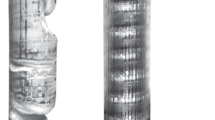Abstract
Much effort recently has been expended to study the strip casting process used to produce thin metal strip with a near final thickness. This process eliminates the need for hot rolling, consumes less energy, and offers a feasible method of producing various hard-to-shape alloys. The finer microstructure that results from the high cooling rate used during the casting process enhances mechanical properties. In this study, strips of phosphor bronzes (Cu-Sn-P) metal were produced using a twin roll strip casting process as well as a conventional horizontal continuous casting (HCC) process. The microstructures, macrosegregations, textures, and mechanical properties of the as-cast and as-rolled metal sheet produced by these two methods were examined carefully for comparative purposes. The results indicate that cast strip produced by a twin roll caster exhibit significantly less inverse segregation of tin compared to that produced by the HCC process. The mechanical properties including tensile strength, elongation, and microhardness of the products produced by the twin roll strip casting process are comparable to those of the HCC processed sheet. These properties meet specifications JIS H3110 and ASTM B 103M for commercial phosphor bronze sheet. The texture of the as-rolled sheet from these two processes, as measured from XRD pole figures, were found to be virtually the same, even though a significant difference exists between them in the as-cast condition.
Similar content being viewed by others
References
P.D. Renschen and B.G. Lewis, Structure-Hot Processability in Copper Base Alloy Casting,Continuous Casting of Non-Ferrous Metals and Alloys, TMS, 1988, p 107–118
W. Reichelt and W. Kapellner, Near-Net-Shape Casting of Flat Products,Metall. Plant and Technol., Vol 48 (No. 2), 1988, p 18–35
K. Shibuya and M. Ozawa, Strip Casting Technique of Steel,ISIJ Int., Vol 31 (No. 7), 1991, p 661–664
B.Q. Li, Producing Thin Strips by Twin-Roll Casting—Part I: Process Aspects and Quality Issues,J. Met, Vol 47 (No. 5), 1995, p 29–33
A. Kasama, S. Tanaka, Y. Itoh, H. Kajika, K. Yanagi, and K. Sasaki, Twin-Drum Casting Process for Stainless Steel Strip,Int. Conf. SRNC-90, The Korean Inst. of Met. and The Inst. of Met. (UK), 1990, p 643–652
M. Tsukigahora, Y. Yamada, M. Mohri, H. Sakaguchi, and K. Fukuda et al., Twin-Roll Strip Caster and Its Products of Stainless Steel,Int. Conf. SRNC-90, The Korean Inst. of Met. and The Inst. of Met. (UK), 1990, p 550–559
K. Shibuya, F. Kogiku, M. Yukumoto, S. Mikake, M. Ozawa, and T. Kan, Development of aRapid Solidification Process with aDouble-Roller Method,Mater. Sci. & Eng. A, Vol 98, 1988, p 25–28
H. Fiedler, M. Jurisch, P. Preiss, R. Gobel, G. Sickert, and H. Zimmermann et al., Thin Strip Casting by a Twin Roller Pilot Plant,Mater. Sci. & Eng. A, Vol 133, 1991, p 671–675
H. Gellenbeck, C. Bartholdt, and F. Prenger, State and Development of Light-Gauge Strip Casting of Copper Alloys,Proc. of 54th Conf. of the GDMB Professional Committee for the Production and the Processing of Copper, March 1994, p 1–7 (in German)
E. Roller and W. Reichelt, Strip Casting Process for Copper Alloys,VD Eisenhutten., 1994, p 480–484 (in German)
E. Essadiqi, J. Blain, L. Mavropoulos, and J. Masounave, Structure and Properties of a Strip-Cast Cu-Ni-Sn and Al-Si-Cu Alloys,Continuous Casting of Non-Ferrous Metals and Alloys, TMS, 1988, p 187–204
JIS Handbook, Non-Ferrous Metals & Metallurgy, 1993, p 542–544
Annual Books of ASTM Standards, Sec. 2, Vol 2.1, 1993, p 144–148
B.D. Cullity,Elements of X-Ray Diffraction, Addison-Wesley Publishing Company, 1978, p 308
J.D. Hwang, H.J. Lin, W.S. Hwang, and C.T. Hu, Relationship between Flow Characteristics and Surface Quality in Inclined Twin Roll Strip Casting,ISIJ Int., Vol 36 (No. 6), 1996, p 690–698
R.N. Caron and S. Shapiro, Mechanism of Yield Strength Enhancement in Heavily Cold Rolled Phosphor Bronze,Metall. Trans. A, Vol 8, 1977, p 111–117
Y.C. Liu and G.A. Alers, The Effects of Penultimate Grain Size on Rolling Texture in Cu-Sn Alloys,Metall. Trans. B, Vol 4, 1973, p 1491–1497
Author information
Authors and Affiliations
Rights and permissions
About this article
Cite this article
Hwang, J.D., Li, B.J., Hwang, W.S. et al. Comparison of phosphor bronze metal sheet produced by twin roll casting and horizontal continuous casting. J. of Materi Eng and Perform 7, 495–503 (1998). https://doi.org/10.1361/105994998770347648
Received:
Revised:
Published:
Issue Date:
DOI: https://doi.org/10.1361/105994998770347648



